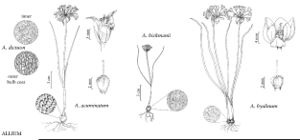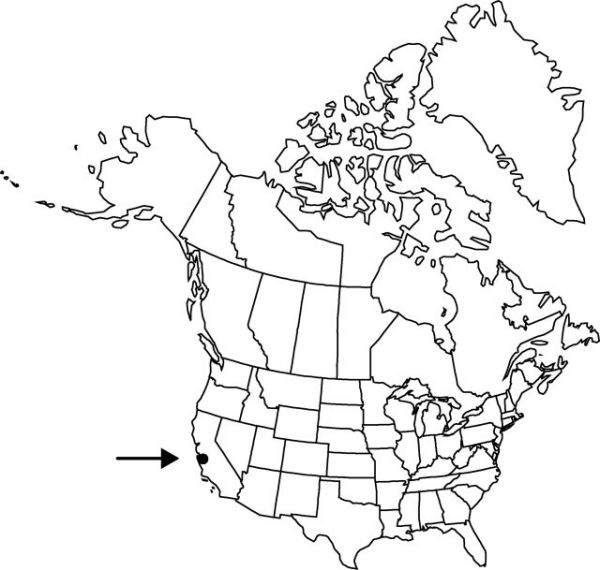Difference between revisions of "Allium hickmanii"
Bull. Torrey Bot. Club 30: 483. 1903.
FNA>Volume Importer |
imported>Volume Importer |
||
| (6 intermediate revisions by 2 users not shown) | |||
| Line 6: | Line 6: | ||
|place=30: 483. 1903 | |place=30: 483. 1903 | ||
|year=1903 | |year=1903 | ||
| + | }} | ||
| + | |special_status={{Treatment/ID/Special_status | ||
| + | |code=F | ||
| + | |label=Illustrated | ||
| + | }}{{Treatment/ID/Special_status | ||
| + | |code=E | ||
| + | |label=Endemic | ||
| + | }}{{Treatment/ID/Special_status | ||
| + | |code=C | ||
| + | |label=Conservation concern | ||
}} | }} | ||
|basionyms= | |basionyms= | ||
| Line 24: | Line 34: | ||
|distribution=Calif. | |distribution=Calif. | ||
|discussion=<p>Of conservation concern.</p><!-- | |discussion=<p>Of conservation concern.</p><!-- | ||
| − | --><p>Allium hickmanii is a rare endemic of the Monterey Peninsula and Arroyo de la Cruz.</p> | + | --><p><i>Allium hickmanii</i> is a rare endemic of the Monterey Peninsula and Arroyo de la Cruz.</p> |
|tables= | |tables= | ||
|references= | |references= | ||
| Line 33: | Line 43: | ||
-->{{#Taxon: | -->{{#Taxon: | ||
name=Allium hickmanii | name=Allium hickmanii | ||
| − | |||
|authority=Eastwood | |authority=Eastwood | ||
|rank=species | |rank=species | ||
| Line 47: | Line 56: | ||
|publication title=Bull. Torrey Bot. Club | |publication title=Bull. Torrey Bot. Club | ||
|publication year=1903 | |publication year=1903 | ||
| − | |special status= | + | |special status=Illustrated;Endemic;Conservation concern |
| − | |source xml=https:// | + | |source xml=https://bitbucket.org/aafc-mbb/fna-data-curation/src/2e0870ddd59836b60bcf96646a41e87ea5a5943a/coarse_grained_fna_xml/V26/V26_486.xml |
|genus=Allium | |genus=Allium | ||
|species=Allium hickmanii | |species=Allium hickmanii | ||
Latest revision as of 21:15, 5 November 2020
Bulbs 1–5+, not clustered on stout primary rhizome, increase bulbs absent or ± equaling parent bulbs, never appearing as basal cluster, ovoid to ± globose, 0.8–1.2 × 0.7–1.2 cm; outer coats enclosing 1 or more bulbs, gray to gray-brown, prominently cellular-reticulate, membranous, cells arranged in ± vertical rows, forming irregular herringbone pattern, transversely elongate, wavy, V-shaped, without fibers; inner coats white, cells obscure, ± quadrate. Leaves persistent, withering from tip by anthesis, 2, basally sheathing, sheaths not extending much above soil level; blades solid, subterete, 3–20 cm × 0.5–1 mm, margins entire. Scape persistent, solitary, erect, solid, terete, (3–)5–15(–17) cm × 0.5–2 mm. Umbel persistent, erect, compact, 4–15-flowered, hemispheric, bulbils unknown; spathe bracts persistent, 2, 3–5-veined, broadly ovate, ± equal, apex mucronate. Flowers campanulate, 5–7 mm; tepals erect, white to pale pink, lanceolate to lance-ovate, ± equal, becoming papery in fruit and remaining erect, margins entire, apex acute or obtuse, becoming ± involute at tip and appearing short-acuminate; stamens included; anthers white; pollen white; ovary crested or crestless; processes 3, central, rounded, very minute, margins entire; style linear, equaling stamens; stigma capitate, scarcely thickened, unlobed; pedicel 4–12 mm. Seed coat dull; cells minutely roughened. 2n = 14.
Phenology: Flowering Mar–May.
Habitat: Grassy, wooded slopes and flats
Elevation: 0–50 m
Discussion
Of conservation concern.
Allium hickmanii is a rare endemic of the Monterey Peninsula and Arroyo de la Cruz.
Selected References
None.

